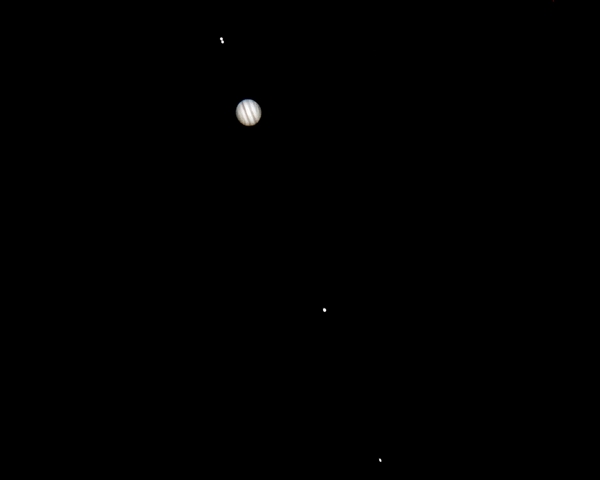JUPITER WITH SATELLITES
2015 February 21, 8:52 p.m. EST (Feb. 22, 01:52 UT)
Rosemary Hill Observatory • Bronson • Florida
« RETURN TO THE MAIN RHO PICTURE PAGE »
RETURN TO PLANET CATEGORIES
RETURN TO PICTURE CATEGORIES
Images © 2004–2015 H.L. Cohen
Email Cohen followed by @astro.ufl.edu
Last updated 2015 May 18
2015 February 21, 8:52 p.m. EST (Feb. 22, 01:52 UT)
Rosemary Hill Observatory • Bronson • Florida
 Photo Details 2015 Feb. 21, 8:51 p.m. EST TeleVue 127 mm, f/5.2 APO Refractor, Foc. Len. 660 mm w/Televue 4x Powermate (Effec. Foc. Len. 2,640 mm) Camera: Canon DSLR EOS 5D II Separate Images of Disk & Satellites Combined Exposures: Disk 1/180 sec & Satellites 1 sec (both @ f/21, ISO 1600) |
OBSERVATIONAL CHALLENGES
(not turned toward Earth in this photo) Oblateness is a measure of "roundness," i.e., having Equatorial Diameter greater than Polar Diameter Definition of Oblateness: Oblateness ≡ (Eq. Diam. - Pol. Diam.)/Eq. Diam.
ANSWER HERE |
« RETURN TO THE MAIN RHO PICTURE PAGE »
RETURN TO PLANET CATEGORIES
RETURN TO PICTURE CATEGORIES
Images © 2004–2015 H.L. Cohen
Email Cohen followed by @astro.ufl.edu
Last updated 2015 May 18